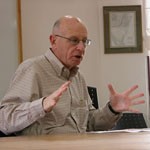
JERUSALEM — Is there anyone within range of this letter who doesn’t know the sad story of George Floyd?
Here, half a world away from Minneapolis, and with our own problems of disease and violence, we’ve seen the film of his murder in custody of Minneapolis police, with his neck under the knee of one officer, while three others were near by. We heard his call that he couldn’t breath, but that brought no relief. Apparently he was picked up for a minor offense, and then killed by an officer with his own record of several complaints for undue violence.
We’ve seen Minneapolis’ Jewish mayor who apologized for the event, as well as the police chief who did the same.
We’ve heard from a cousin, a brother, and Floyd’s partner, who appeared in stylish clothes with huge painted fingernails, and their young daughter.
There’s also been coverage of violence extending for more than a week across America, with both peaceful marches by Blacks and Whites, and trashing by both younger Blacks and some Whites.
We’ve heard that the trashers are gang members, and from far away. But no substantiation of either claim.
There have been interviews with former Israelis who have owned a clothing store and a jewelry store in Los Angeles that have been cleaned out and burned.
And we’ve seen President Donald Trump, with his Bible, walking to a church close to the White House, one of whose preachers expressed something other than support for the President’s actions.
Those included his assertion that he’d use the force of the US military to deal decisively with those who threatened American lives and property.
Then something else heard from Defense Department officials about the need, and the President’s power to use military force against Americans.
There has been lots of conflict between governors, mayors, police chiefs, and the President about who has the authority, and who should do what by way of dealing with the latest and perhaps the greatest and lengthiest confrontation about race, police, the National Guard, other military units, and their proper relationships to the American public.
Has it been the worst example of racial conflict since the also filmed police beating of Rodney King in Los Angeles in 1991, and no end of other cases that have given rise to Black Lives Matter and other movements?
It comes along with the Coronavirus pandemic that has also affected Black and other minority communities heavily, with high unemployment and frustrations, as well as the pervasive cell phones and mass communication producing an outrage that includes many Whites as well as Blacks.
Sure, it’s yet another example of American racism, along with riots largely by young Blacks likely to reinforce that racism among the substantial White sector that supports Donald Trump. And it triggers the anti-racism of Blacks and Whites offended by the film of Floyd’s murder.
We’re reminded, by interviews with articulate Black males of their problems encountering police (and others).
And we’ve heard a White police chief saying that if the President does not have anything constructive to say about the situation he should shut up.
No doubt the film about Floyd’s murder will be used in police classes throughout the country, just as was the film of Rodney King’s beating.
This will not be the end of racism in America. But it may indicate the rise of a substantial White component that expresses something against the racism of others.
The pictures we’ve seen show a large number of Whites marching along with Blacks across the US. And supporting demonstrations, some with violence, in Britain, Canada, Europe, and Australia.
What about the population that the President represents?
It’s unlikely to end. The violence will add to the racism. Calm will come, but the division of American society will not go away.
It began with slavery, accepted throughout the South and some other locales; with opposition from Abolitionists and like minded folks. Individual Blacks surfaced and succeeded, but others did not. A movement northward, to work, while those left behind suffered from segregation until the mid-1960s. Labels changed, from N….r, Negro, Black, and Afro-American. Intermarriage proceeded, so far to produce one American President. Others have reached the highest levels of government, commerce, journalism, the universities, churches, stage and music.
But many live without the stability of marriage with two parents.
An autopsy revealed that George Floyd was suffering from Coronavirus. The lack of freely available medical care may keep many others ill with one thing or another. Records of life expectancy, prison population, and figures for education show stark differences by race..
It’s not yet a healthy country. And the President’s supporters show another side, very much in the way of what some describe as the American dream.
Israel has had its own problems, between police and Ethiopians, along with violent protests. So far, nothing as prolonged and destructive as has marked the United States.
Race is a problem, big or not so. Jews know. Or they should.
*
Ira Sharkansky, PhD is professor emeritus of political science at Hebrew University. He may be contacted via ira.sharkansky@sdjewishworld.com